TOYOTA LAND CRUISER 2012 Owners Manual
Manufacturer: TOYOTA, Model Year: 2012, Model line: LAND CRUISER, Model: TOYOTA LAND CRUISER 2012Pages: 692, PDF Size: 29.3 MB
Page 511 of 692
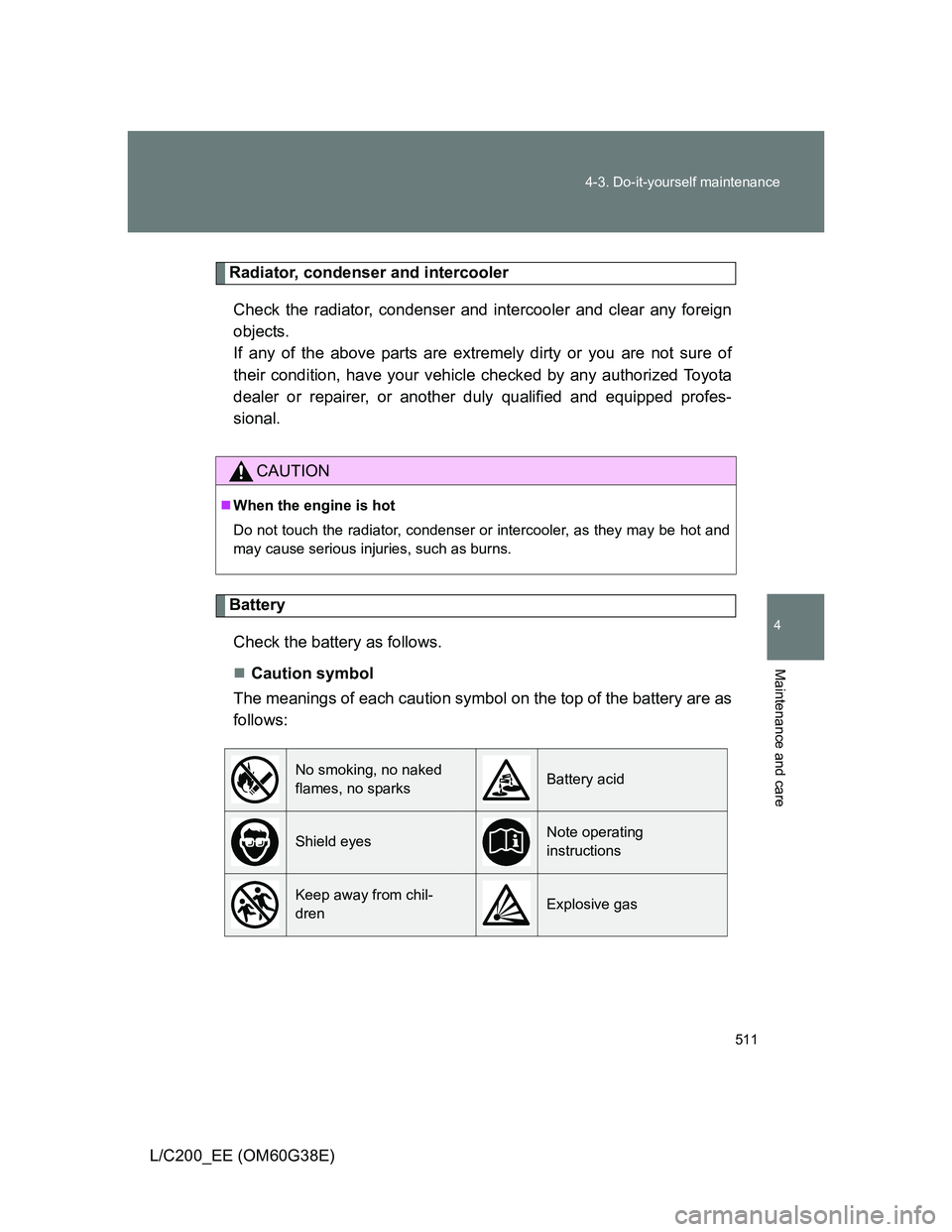
511 4-3. Do-it-yourself maintenance
4
Maintenance and care
L/C200_EE (OM60G38E)
Radiator, condenser and intercooler
Check the radiator, condenser and intercooler and clear any foreign
objects.
If any of the above parts are extremely dirty or you are not sure of
their condition, have your vehicle checked by any authorized Toyota
dealer or repairer, or another duly qualified and equipped profes-
sional.
Battery
Check the battery as follows.
Caution symbol
The meanings of each caution symbol on the top of the battery are as
follows:
CAUTION
When the engine is hot
Do not touch the radiator, condenser or intercooler, as they may be hot and
may cause serious injuries, such as burns.
No smoking, no naked
flames, no sparksBattery acid
Shield eyesNote operating
instructions
Keep away from chil-
drenExplosive gas
Page 512 of 692
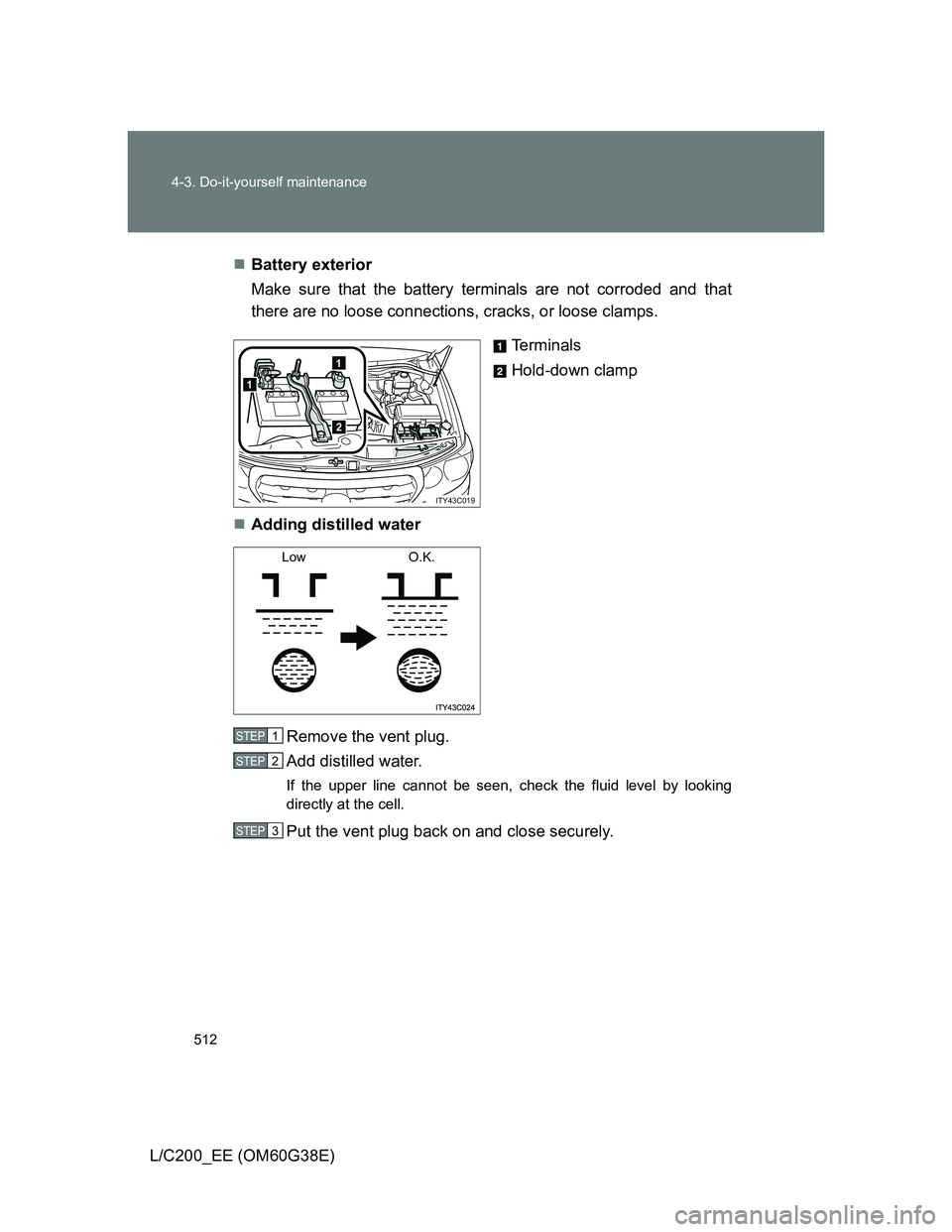
512 4-3. Do-it-yourself maintenance
L/C200_EE (OM60G38E)Battery exterior
Make sure that the battery terminals are not corroded and that
there are no loose connections, cracks, or loose clamps.
Terminals
Hold-down clamp
Adding distilled water
Remove the vent plug.
Add distilled water.
If the upper line cannot be seen, check the fluid level by looking
directly at the cell.
Put the vent plug back on and close securely.
1
1
2
ITY43C019
Low O.K.
STEP1
STEP2
STEP3
Page 513 of 692
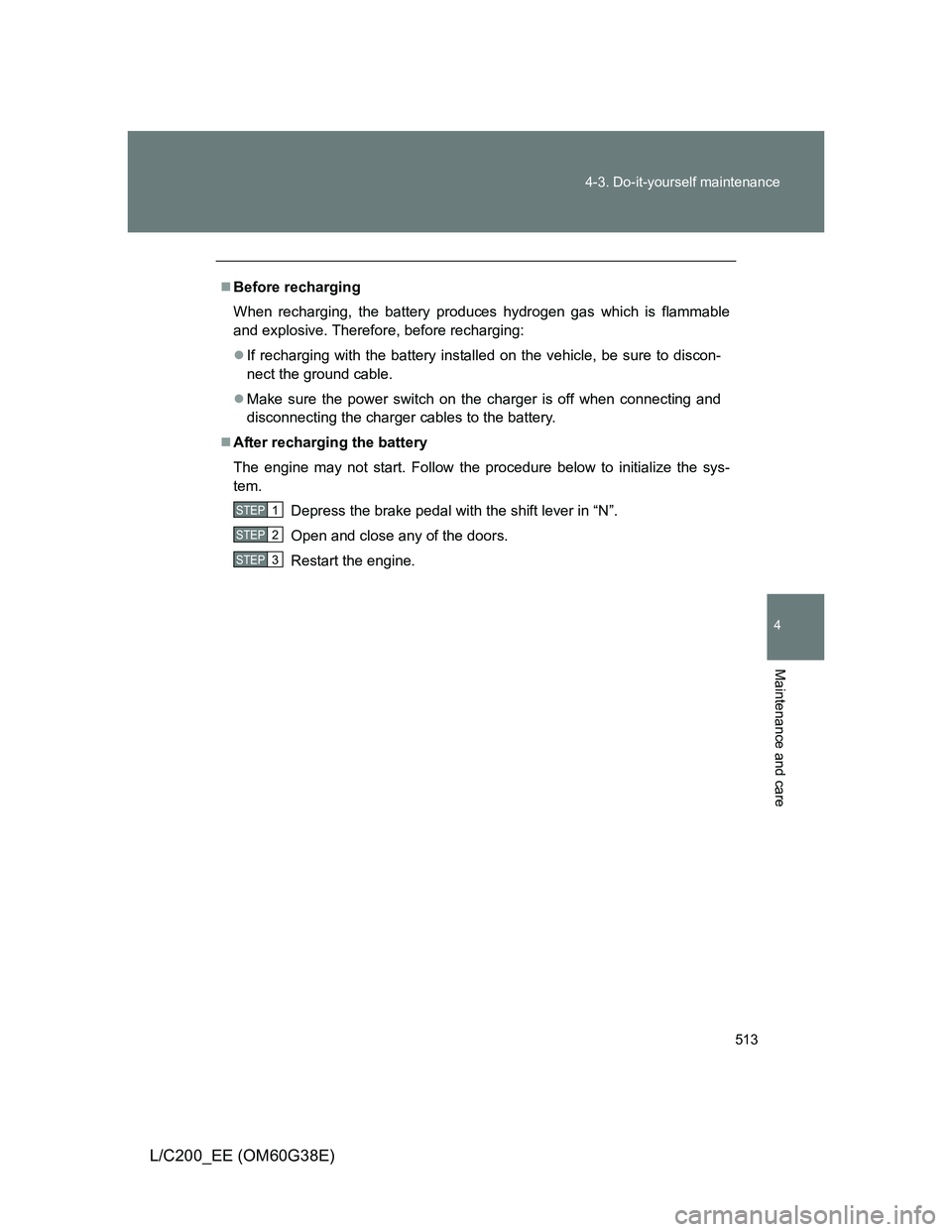
513 4-3. Do-it-yourself maintenance
4
Maintenance and care
L/C200_EE (OM60G38E)
Before recharging
When recharging, the battery produces hydrogen gas which is flammable
and explosive. Therefore, before recharging:
If recharging with the battery installed on the vehicle, be sure to discon-
nect the ground cable.
Make sure the power switch on the charger is off when connecting and
disconnecting the charger cables to the battery.
After recharging the battery
The engine may not start. Follow the procedure below to initialize the sys-
tem.
Depress the brake pedal with the shift lever in “N”.
Open and close any of the doors.
Restart the engine.
STEP1
STEP2
STEP3
Page 514 of 692
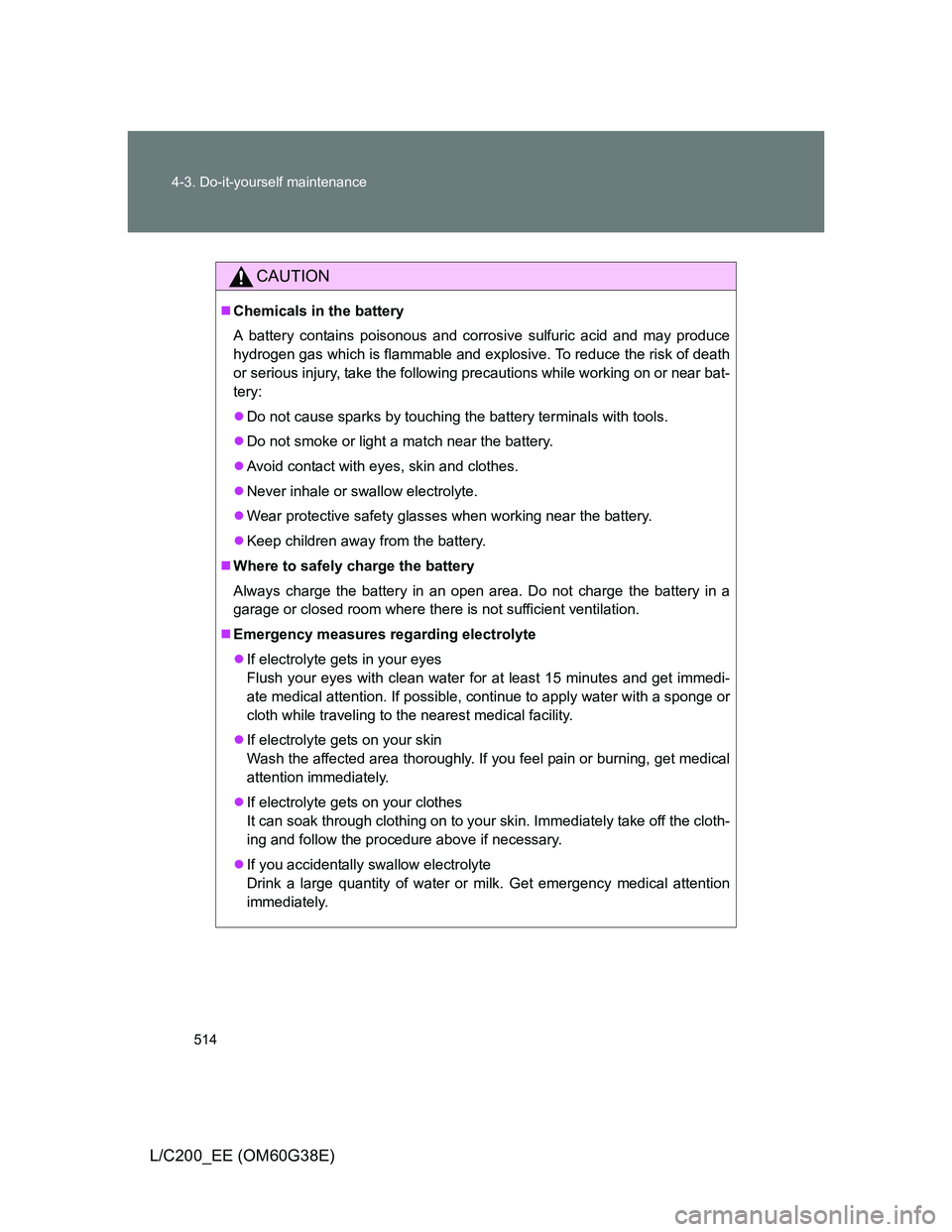
514 4-3. Do-it-yourself maintenance
L/C200_EE (OM60G38E)
CAUTION
Chemicals in the battery
A battery contains poisonous and corrosive sulfuric acid and may produce
hydrogen gas which is flammable and explosive. To reduce the risk of death
or serious injury, take the following precautions while working on or near bat-
tery:
Do not cause sparks by touching the battery terminals with tools.
Do not smoke or light a match near the battery.
Avoid contact with eyes, skin and clothes.
Never inhale or swallow electrolyte.
Wear protective safety glasses when working near the battery.
Keep children away from the battery.
Where to safely charge the battery
Always charge the battery in an open area. Do not charge the battery in a
garage or closed room where there is not sufficient ventilation.
Emergency measures regarding electrolyte
If electrolyte gets in your eyes
Flush your eyes with clean water for at least 15 minutes and get immedi-
ate medical attention. If possible, continue to apply water with a sponge or
cloth while traveling to the nearest medical facility.
If electrolyte gets on your skin
Wash the affected area thoroughly. If you feel pain or burning, get medical
attention immediately.
If electrolyte gets on your clothes
It can soak through clothing on to your skin. Immediately take off the cloth-
ing and follow the procedure above if necessary.
If you accidentally swallow electrolyte
Drink a large quantity of water or milk. Get emergency medical attention
immediately.
Page 515 of 692
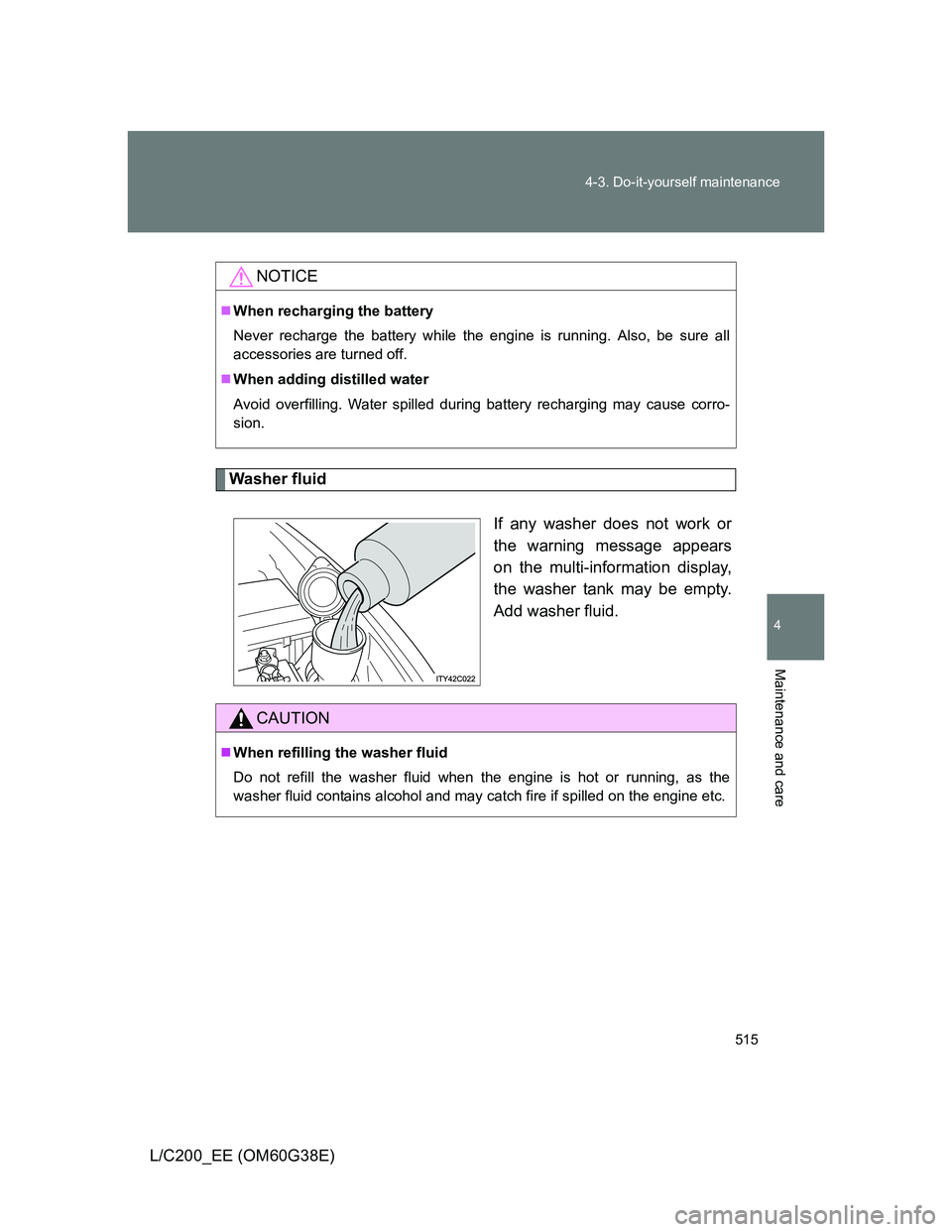
515 4-3. Do-it-yourself maintenance
4
Maintenance and care
L/C200_EE (OM60G38E)
Washer fluid
If any washer does not work or
the warning message appears
on the multi-information display,
the washer tank may be empty.
Add washer fluid.
NOTICE
When recharging the battery
Never recharge the battery while the engine is running. Also, be sure all
accessories are turned off.
When adding distilled water
Avoid overfilling. Water spilled during battery recharging may cause corro-
sion.
CAUTION
When refilling the washer fluid
Do not refill the washer fluid when the engine is hot or running, as the
washer fluid contains alcohol and may catch fire if spilled on the engine etc.
Page 516 of 692
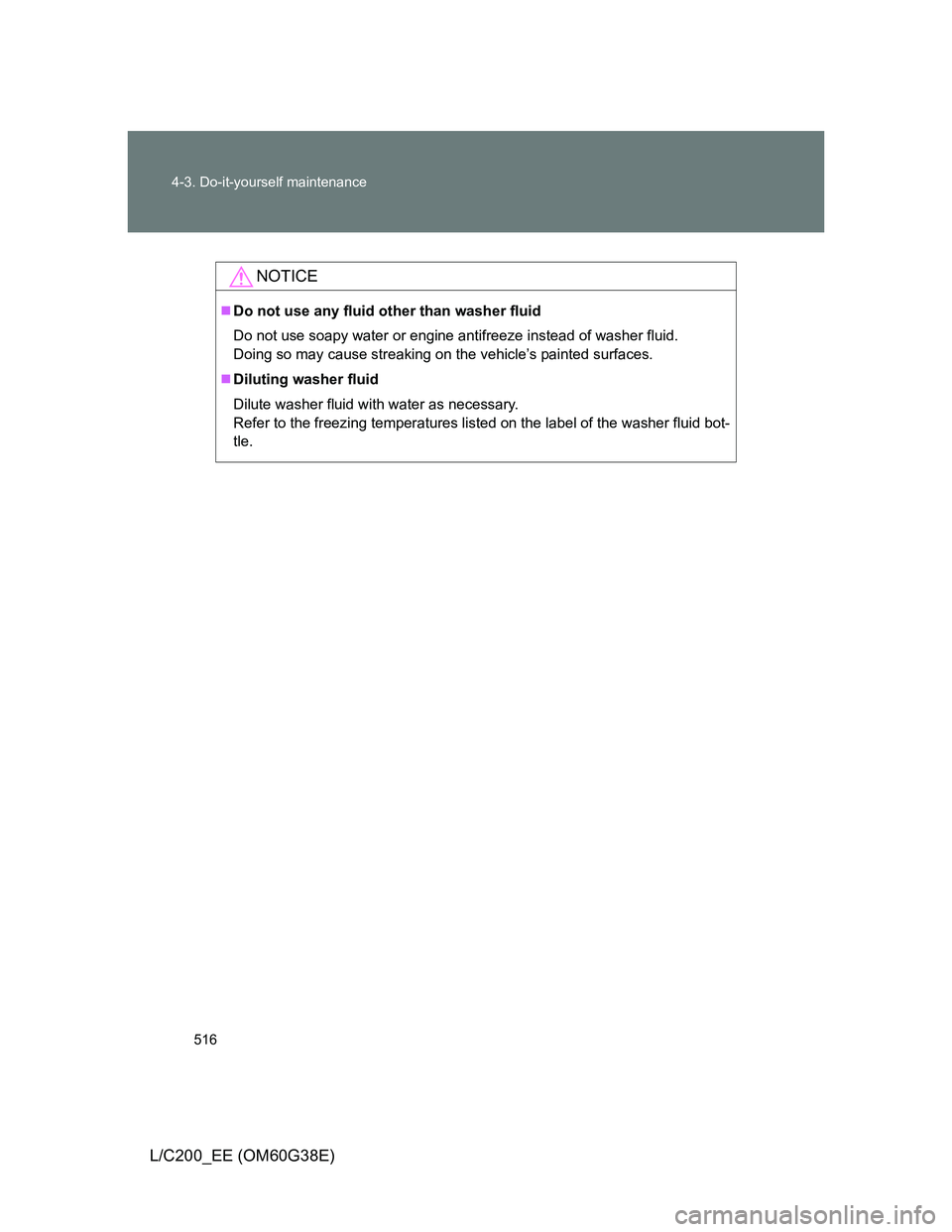
516 4-3. Do-it-yourself maintenance
L/C200_EE (OM60G38E)
NOTICE
Do not use any fluid other than washer fluid
Do not use soapy water or engine antifreeze instead of washer fluid.
Doing so may cause streaking on the vehicle’s painted surfaces.
Diluting washer fluid
Dilute washer fluid with water as necessary.
Refer to the freezing temperatures listed on the label of the washer fluid bot-
tle.
Page 517 of 692
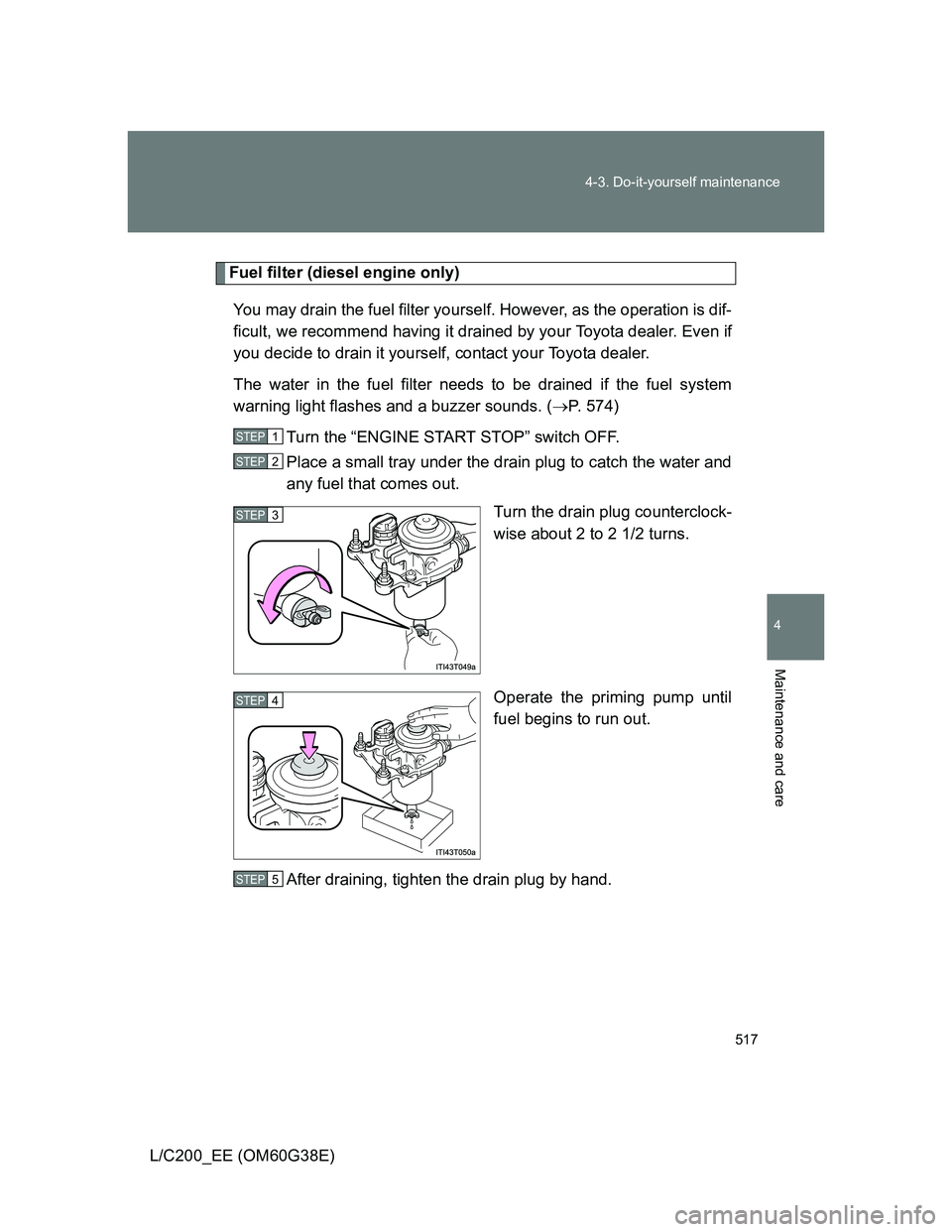
517 4-3. Do-it-yourself maintenance
4
Maintenance and care
L/C200_EE (OM60G38E)
Fuel filter (diesel engine only)
You may drain the fuel filter yourself. However, as the operation is dif-
ficult, we recommend having it drained by your Toyota dealer. Even if
you decide to drain it yourself, contact your Toyota dealer.
The water in the fuel filter needs to be drained if the fuel system
warning light flashes and a buzzer sounds. (P. 574)
Turn the “ENGINE START STOP” switch OFF.
Place a small tray under the drain plug to catch the water and
any fuel that comes out.
Turn the drain plug counterclock-
wise about 2 to 2 1/2 turns.
Operate the priming pump until
fuel begins to run out.
After draining, tighten the drain plug by hand.
STEP1
STEP2
STEP3
STEP4
STEP5
Page 518 of 692
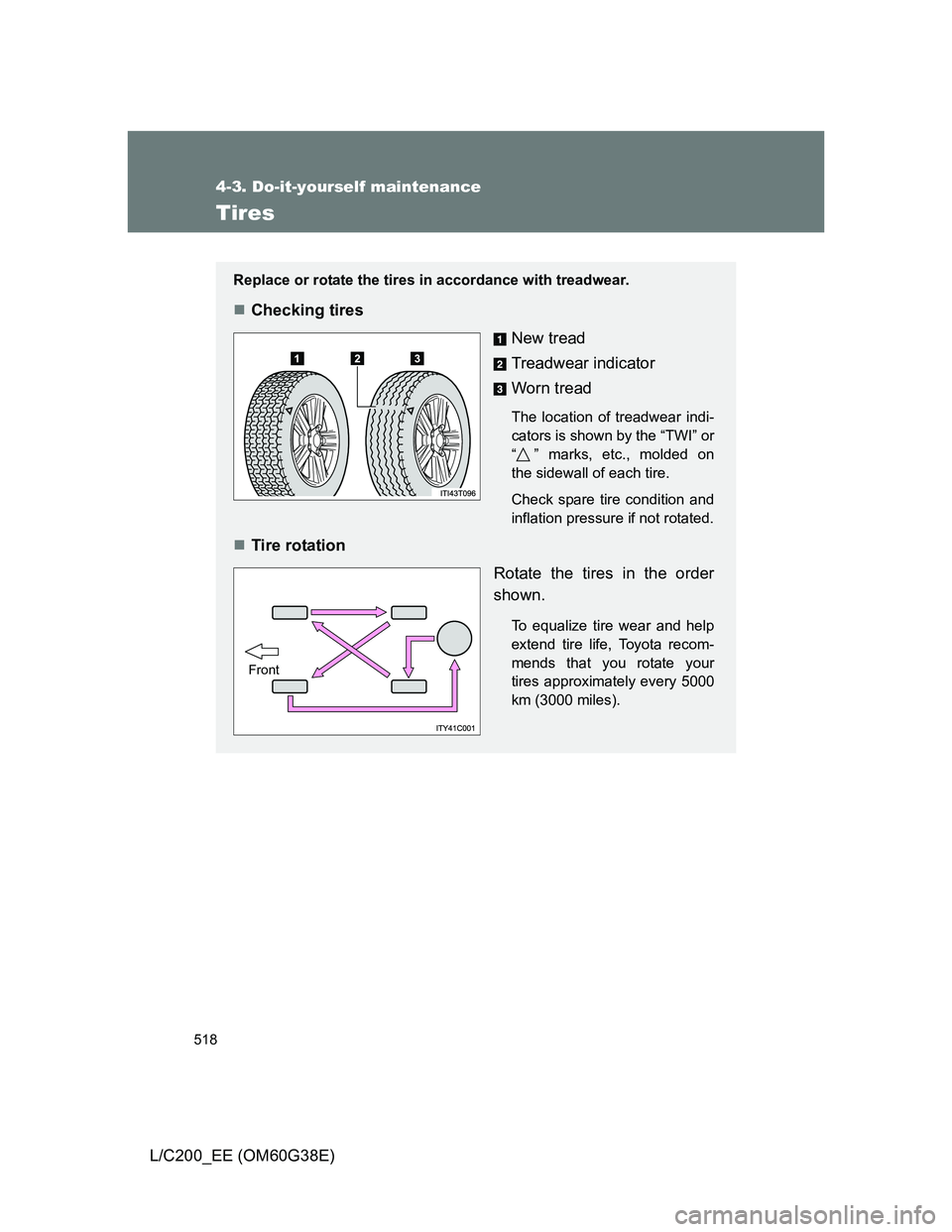
518
4-3. Do-it-yourself maintenance
L/C200_EE (OM60G38E)
Tires
Replace or rotate the tires in accordance with treadwear.
Checking tires
New tread
Treadwear indicator
Worn tread
The location of treadwear indi-
cators is shown by the “TWI” or
“ ” marks, etc., molded on
the sidewall of each tire.
Check spare tire condition and
inflation pressure if not rotated.
Tire rotation
Rotate the tires in the order
shown.
To equalize tire wear and help
extend tire life, Toyota recom-
mends that you rotate your
tires approximately every 5000
km (3000 miles).
Front
Page 519 of 692
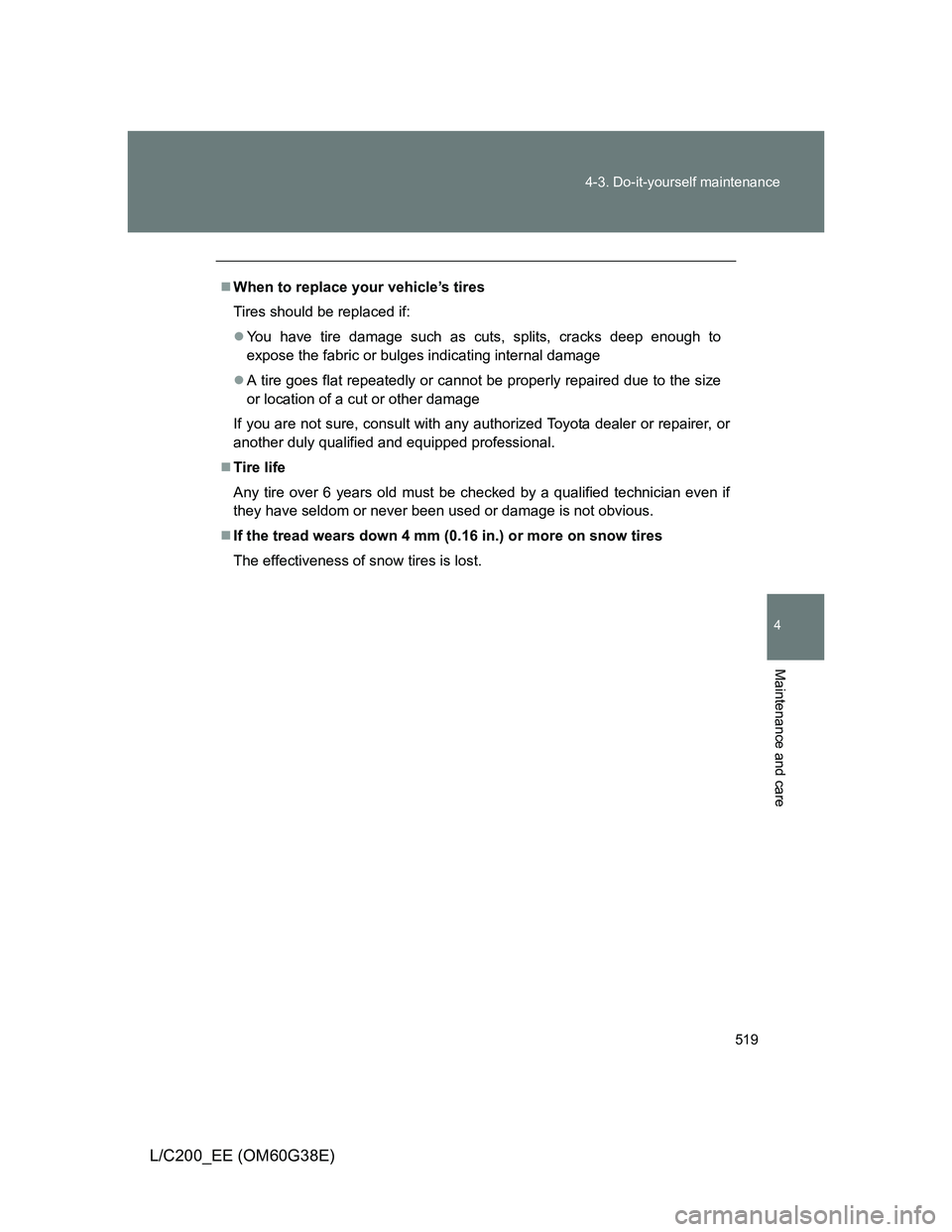
519 4-3. Do-it-yourself maintenance
4
Maintenance and care
L/C200_EE (OM60G38E)
When to replace your vehicle’s tires
Tires should be replaced if:
You have tire damage such as cuts, splits, cracks deep enough to
expose the fabric or bulges indicating internal damage
A tire goes flat repeatedly or cannot be properly repaired due to the size
or location of a cut or other damage
If you are not sure, consult with any authorized Toyota dealer or repairer, or
another duly qualified and equipped professional.
Tire life
Any tire over 6 years old must be checked by a qualified technician even if
they have seldom or never been used or damage is not obvious.
If the tread wears down 4 mm (0.16 in.) or more on snow tires
The effectiveness of snow tires is lost.
Page 520 of 692
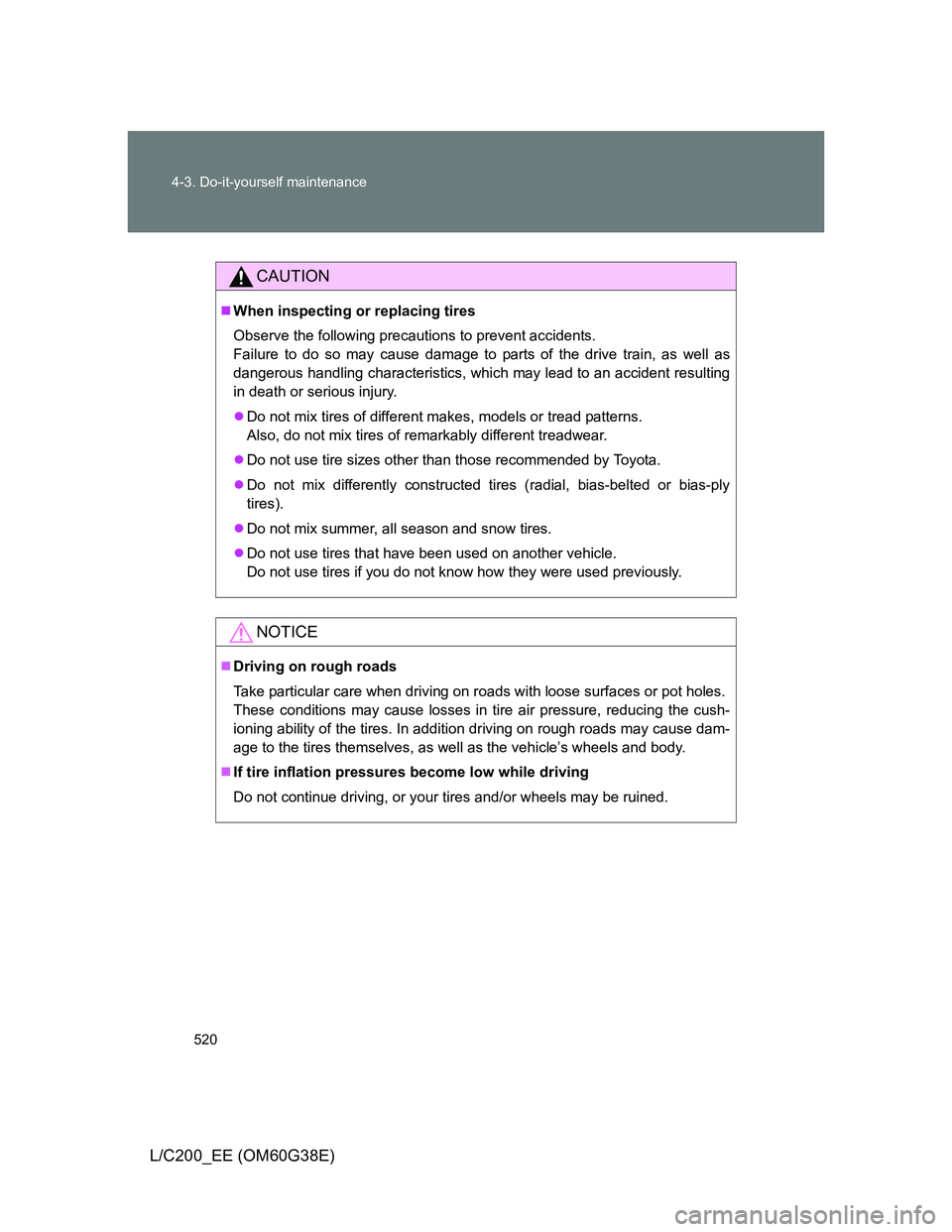
520 4-3. Do-it-yourself maintenance
L/C200_EE (OM60G38E)
CAUTION
When inspecting or replacing tires
Observe the following precautions to prevent accidents.
Failure to do so may cause damage to parts of the drive train, as well as
dangerous handling characteristics, which may lead to an accident resulting
in death or serious injury.
Do not mix tires of different makes, models or tread patterns.
Also, do not mix tires of remarkably different treadwear.
Do not use tire sizes other than those recommended by Toyota.
Do not mix differently constructed tires (radial, bias-belted or bias-ply
tires).
Do not mix summer, all season and snow tires.
Do not use tires that have been used on another vehicle.
Do not use tires if you do not know how they were used previously.
NOTICE
Driving on rough roads
Take particular care when driving on roads with loose surfaces or pot holes.
These conditions may cause losses in tire air pressure, reducing the cush-
ioning ability of the tires. In addition driving on rough roads may cause dam-
age to the tires themselves, as well as the vehicle’s wheels and body.
If tire inflation pressures become low while driving
Do not continue driving, or your tires and/or wheels may be ruined.